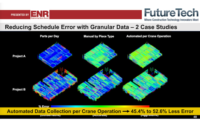Dublin Airport is pursuing a $1.8-billion capital investment program digitally, with more than 140 projects being delivered using the Autodesk Construction Cloud platform. Dublin Airport Authority onboarded more than 200 supplier companies to work in its connected data platform.
“We began implementation of BIM 360 back in 2019,” says Jean-Manuel LeJeune, head of digital transformation and information management with Dublin Airport Authority (daa). “We’ve been migrating to ACC since 2022, using the ACC suite of tools. We are working with 250 companies, 1,600 people and 140 projects in standardized delivery processes. All of that is in a controlled environment.”
A baggage handling project in 2019 was the first to be implemented, and “it’s been all ACC since,” LeJeune adds. “We have half a million documents embedded for a billion euros’ ($1.06 billion) worth of projects.”
The capital investment program is meant to allow the airport to accommodate a forecast of 40 million passengers per year by 2030 and enable daa to deliver on its commitment to reduce carbon emissions by 51% by 2030 and to help achieve net-zero energy usage by 2050.
The CIP consists of more than 140 projects in categories ranging from asset maintenance (drainage, electric charging, airfield lighting, etc.), sustainability (photovoltaic farms, energy, electric fleets), capacity (vehicle underpass, new concourse, security search expansion early baggage storage, surface water), security (new scanners, body scanners and a logistics center), commercial (lounges, parking areas), and technology (digital passenger experience, biometrics and data analytics).
“We’ve been working with daa for a number of years, particularly in Revit, Autocad, and the Civil 3D design suite,” says Jim Lynch, general manager of Autodesk Construction. The connected construction concept means “envisioning an entire digital ecosystem, optimized from the start,” he adds. “We don’t wait until we’re out on the jobsite to start using technology. It starts in conceptual planning and preconstruction with our suite for takeoffs, estimating RFIs … then project and cost management during the job and then operations and maintenance.”
According to daa, the review process is three-and-half times faster in ACC than traditional processes, with 19,000 documents submitted and nearly 6,000 reviews carried out across 60 projects in 2023. Resolution of issues went three times faster, and RFI processes one-and-a-half times faster.
The authority is piloting digital twin tool Tandem to build a connected ecosystem for all the airport’s assets, spaces and systems. “We’re using Tandem to see if we can integrate it into the [existing] model,” says LeJeune.
The goal is to simplify and improve workflows between constituents of a project by automating and connecting data, says Lynch. “What we’re really trying to do is invest in ease of use—making it visual—what a condition is supposed to look like.” Data goes bidirectionally from construction back to preconstruction, planning and design and downstream to maintenance and operations.
“We ask contractors to work in this environment for site inspections,” Lynch adds. “They submit their information into the platform. We transfer the information to the client environment.”
LeJeune says Tandem is undergoing a proof of concept. “The question is will asset management link directly to ACC,” he says. “We’re ready to have everything stored in ACC and all other platforms to access it. How much in resources do we invest? What is the redundancy of old versus new assets? This is my battle for 2024. We’re all learning together.”






Post a comment to this article
Report Abusive Comment